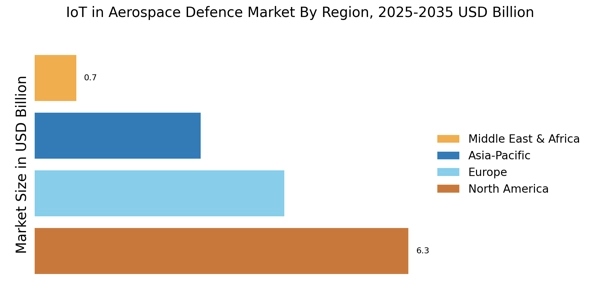Advancements in Sensor Technologies
The IoT in Aerospace Defence Market is significantly influenced by advancements in sensor technologies. These innovations enable the development of more sophisticated and reliable sensors that can be deployed in various defense applications. Enhanced sensors facilitate better monitoring of aircraft systems, environmental conditions, and battlefield scenarios. For instance, the integration of IoT-enabled sensors in unmanned aerial vehicles (UAVs) has improved their operational capabilities, allowing for more precise reconnaissance and surveillance missions. The increasing investment in sensor technology is expected to propel the market, with projections indicating a potential growth rate of 20% over the next five years.
Increased Demand for Real-Time Data
The IoT in Aerospace Defence Market is witnessing a surge in demand for real-time data analytics. This trend is driven by the need for enhanced situational awareness and decision-making capabilities in defense operations. With the integration of IoT technologies, military organizations can collect and analyze vast amounts of data from various sensors and devices in real-time. This capability allows for quicker responses to threats and improved operational efficiency. According to recent estimates, the market for IoT in aerospace and defense is projected to reach USD 30 billion by 2026, reflecting a compound annual growth rate of approximately 25%. Such growth underscores the critical role of real-time data in modern defense strategies.
Integration of Artificial Intelligence
The integration of artificial intelligence (AI) within the IoT in Aerospace Defence Market is transforming operational capabilities. AI algorithms can analyze data collected from IoT devices to identify patterns, predict outcomes, and enhance decision-making processes. This synergy between IoT and AI enables defense organizations to optimize resource allocation, improve mission planning, and enhance threat detection. The market for AI in defense applications is projected to grow significantly, with estimates suggesting a potential increase of 30% by 2027. This growth indicates a strong trend towards leveraging advanced technologies to enhance the effectiveness of defense operations.
Growing Focus on Predictive Maintenance
The IoT in Aerospace Defence Market is increasingly focusing on predictive maintenance strategies. By leveraging IoT technologies, defense organizations can monitor the health of their equipment and predict potential failures before they occur. This proactive approach not only reduces downtime but also extends the lifespan of critical assets. The implementation of predictive maintenance solutions is anticipated to save defense organizations millions in repair costs and operational disruptions. As a result, the market for IoT in predictive maintenance within the aerospace and defense sector is expected to grow at a rate of 18% annually, highlighting its importance in maintaining operational readiness.
Regulatory Support and Funding Initiatives
The IoT in Aerospace Defence Market is benefiting from increased regulatory support and funding initiatives from various governments. These initiatives aim to modernize defense capabilities and enhance national security through the adoption of IoT technologies. Governments are recognizing the strategic importance of IoT in defense and are allocating substantial budgets to support research and development in this area. For instance, recent funding announcements indicate a commitment of over USD 5 billion towards IoT-related defense projects in the next few years. This financial backing is likely to accelerate innovation and adoption of IoT solutions in the aerospace and defense sectors.


















Leave a Comment